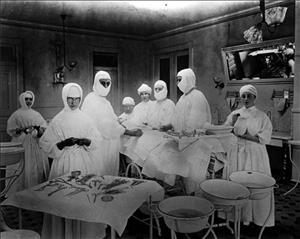On August 17, 1891, members of the Sisters of Charity of Providence, a Catholic teaching and nursing order, open St. Elizabeth Hospital, the first hospital facility in the Yakima area.
Members of the Sisters of Charity of Providence order had come to the Yakima area in 1875 and established the St. Joseph school (later Academy), the first school in the Yakima valley.
Dr. T. B. Gunn, the physician for the United States Reclamation Service then building the Sunnyside Canal, was the initial impetus behind the move to establish a hospital in North Yakima. Dr. Gunn was especially concerned that there be hospital facilities available for the government employees working on the canal project. Apparently he had no official funding to create such facilities, however, and suggested to the sisters that they take on the project.
Mother Peter of Alcantara and another sister asked (many accounts say begged) for donations on Yakima street corners and by going from door to door. In three days they had raised $300. The nuns then set out on horseback accompanied by a guide to solicit funds from ranchers along the Sunnyside canal. The presence of the canal probably increased the risk of typhoid fever, and Yakima valley residents had as yet few doctors and no hospitals.
Mother Peter succeeded in raising sufficient funds to rent a seven-room, two-story frame house on the north side of Yakima Avenue between Naches and 4th Street for $12 per month. The sisters cleaned the house thoroughly, laid carpets, and applied paint and wallpaper. The hospital could accommodate 13 patients at a time. Sister Mary Hercule and Sister John the Evangelist were put in charge. The sisters also apparently made house calls.
Double Duty
James Dunworth, age 26, was the first patient to take advantage of the facility. He stayed about a month before being discharged. Altogether, 37 patients were cared for at St. Elizabeth during 1891.
Dr. Gunn performed the hospital's first surgery, the amputation of C. Longmire's leg. The kitchen table served as operating table and the wood-burning kitchen stove was pressed into service to sterilize the surgical instruments. This arrangement continued for some years -- presumably surgeries were scheduled to prevent sterilization activities from overlapping with meal preparation.
An Ecumenical Effort
St. Elizabeth Hospital served all in need, not just Catholics, and received support from a wide spectrum of North Yakima's population. In addition to donations from parishioners at St. Michael's Episcopal Church (the oldest church in Yakima) and St. Joseph Church (Catholic), various fraternal organizations such as the Odd Fellows supported the hospital's mission.
The small hospital was overtaxed almost immediately and Mother Peter began soliciting donations for a larger facility. She purchased four lots at 4th and E streets. The Yakima firm of Langert, Schreiner, Ley, and Meyers signed a contract to construct a new 25-bed hospital, which opened on August 23, 1892. Patients with infectious diseases (often typhoid or tuberculosis) were housed in open air wards in three large screened tents. A 1902 addition created the first real operating theater. Two additional wings brought patient capacity to 65.
On January 1, 1914 St. Elizabeth's moved to a new five-story brick building at 110 S. 9th Avenue on Yakima's Capitol Hill. William V. Holden oversaw construction. Complete with elevators and isolation rooms, this facility served patients from throughout the Yakima valley until 1963 when it was demolished to make way for a new facility on the same site. The new building was completed in 1965. A new wing was added in 1975 and a rooftop helicopter pad in 1979.
In 2003 the hospital, by then called Providence Yakima Medical Center, was sold to a Health Management Associates, a major operator of acute care hospitals in rural areas. The facility was renamed the Yakima Regional Medicine and Cardiac Care Center. In 2020, by then known as Astria Regional Medical Center, it closed.

